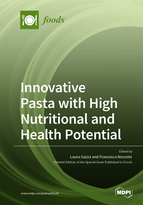Innovative Pasta with High Nutritional and Health Potential
A special issue of Foods (ISSN 2304-8158). This special issue belongs to the section "Grain".
Deadline for manuscript submissions: closed (28 September 2021) | Viewed by 37232
Special Issue Editors
Interests: wheat; minor cereals; cereal quality; gluten; gluten intolerances; gluten-free; pasta; cereals processing; bioactive compounds; functional foods; plant biotechnology; breeding for quality
Special Issues, Collections and Topics in MDPI journals
Interests: wheat; cereal quality; pasta; cereals processing; cereal technology; bioactive compounds; functional foods; malt; beer; cereal pathology; vegetable milks
Special Issues, Collections and Topics in MDPI journals
Special Issue Information
Dear Colleagues,
Dry pasta is one of the most popular staple foods worldwide due to its convenience in terms of affordability, versatility, long shelf life, as well as sensory and nutritional value. As such, it represents a suitable carrier for health-promoting substances providing specific physiological functions.
This Special Issue deals with the continuum aspects, “from seed to fork”, that could have an impact on the nutritional, sensory, and technological aspects of pasta. In this Special Issue, we aim to publish innovative research and review papers on physico-chemical and sensorial characteristics, nutritional value, functional and technological properties of pasta, and pasta-making processes. New raw materials, new functional ingredients, up-cycling of waste materials, in vivo experiments to test the effect of assumption of the supplemented pasta, and innovative packaging systems will also be addressed in this Special Issue. Predictions of pasta quality adopting chemometrics as well as multi-variate and statistical data analysis approaches are welcomed.
Finally, in the medium term, the international pasta market is expected to stay negative unless tangible product innovations are introduced, particularly regarding the technological innovations aimed at improving the products’ health benefits. This Special Issue aims to provide a fundamental understanding and present the current strategies to improve the technological, nutritional, and sensory properties of pasta.
Dr. Laura Gazza
Dr. Francesca Nocente
Guest Editors
Manuscript Submission Information
Manuscripts should be submitted online at www.mdpi.com by registering and logging in to this website. Once you are registered, click here to go to the submission form. Manuscripts can be submitted until the deadline. All submissions that pass pre-check are peer-reviewed. Accepted papers will be published continuously in the journal (as soon as accepted) and will be listed together on the special issue website. Research articles, review articles as well as short communications are invited. For planned papers, a title and short abstract (about 100 words) can be sent to the Editorial Office for announcement on this website.
Submitted manuscripts should not have been published previously, nor be under consideration for publication elsewhere (except conference proceedings papers). All manuscripts are thoroughly refereed through a single-blind peer-review process. A guide for authors and other relevant information for submission of manuscripts is available on the Instructions for Authors page. Foods is an international peer-reviewed open access semimonthly journal published by MDPI.
Please visit the Instructions for Authors page before submitting a manuscript. The Article Processing Charge (APC) for publication in this open access journal is 2900 CHF (Swiss Francs). Submitted papers should be well formatted and use good English. Authors may use MDPI's English editing service prior to publication or during author revisions.
Keywords
- Pasta
- Whole-meal
- Gluten-free
- Wheat sensitivity
- Nutritional value of pasta
- Functional pasta
- Sensory and technological quality
- Physico-chemical characteristics
- Current tools for pasta quality prediction
- Omics of pasta qualities








